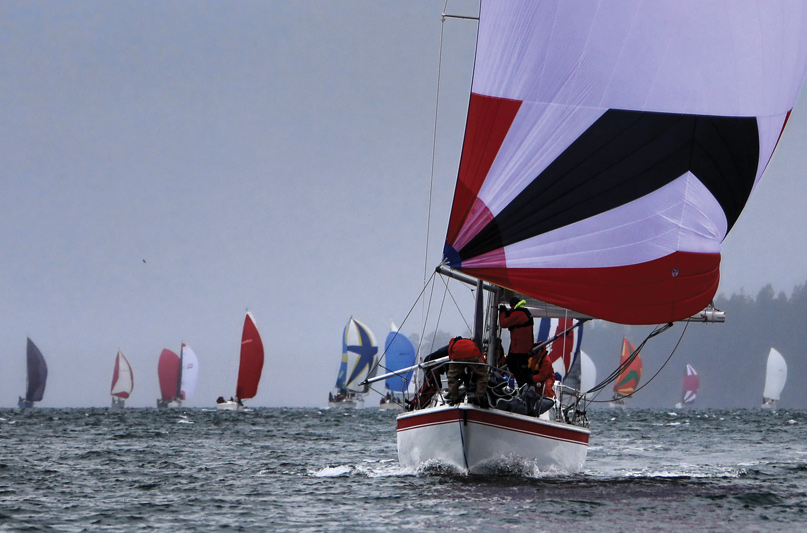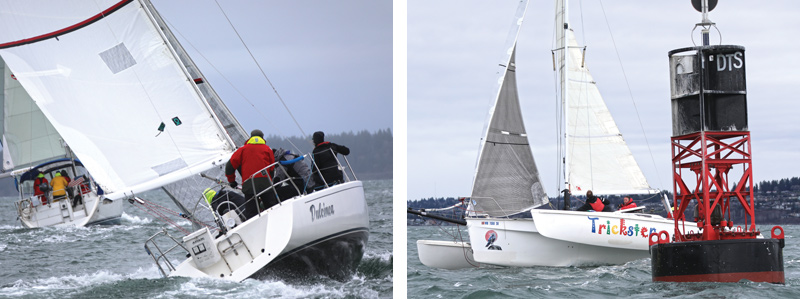
While some of the best sailors in western Washington claim there is no sailing south of Alki, clearly, they have not gone far enough. Marking the second half of the season-bending South Sound Series, the Toliva Shoals race once again knocked it out of the park for a fantastic day on the water. While the fleet enjoyed a relatively calm delivery south from Seattle, the wind had some tricks in store for race day.
A gusty breeze starting out in the high teens welcomed sailors after a cramped car ride down I-5. The forecast had everyone excited for the first big wind race of the year and those of us on board
Absolutely, Charlie Macaulay’s Farr 39, were eager to shake things out. Motoring out to the start line felt almost boring, but we were quickly corrected. We exited the channel with no sail up and were nearly knocked down from what must have been the largest puff of the day. We headed upwind to hoist the mainsail and rigged things to allow us to shorten sails by reefing, a rare experience in the Northwest.
Working out towards the start line, crews perked up as 25-knot puffs came rolling down the bay from the capitol building. We watched the cruising classes get underway with a fair bit of excitement as large spinnakers were set and 1980’s death rolls commenced. Alternating between spinnaker pole and boom touching the water is never a good sign, but within minutes things settled down, the racing fleet sequence began to take shape, and the tempo of race day took over.
The fleets got underway with little drama and moved quickly as the wind built behind them. The name of the game for this race was traffic management. Even on board the nimble Absolutely, we found ourselves intermixed with the bulk of the fleet for most of the race. The opening spinnaker run off the line had its fair share of excitement, but with big boats “shrimping” spinnakers and little boats making huge gains by never setting a kite to begin with, it was a mixed bag.
As the day continued, our focus shifted to optimizing what wind we had, with the breeze going from 20 to 2 knots in a matter of seconds and back to 20 in half that. Staying in the pressure and making the best of the twists and turns of the course quickly separated the fleet through the narrow racecourse. The final run to the turning mark at Toliva Shoals was the make or break point. Top speeds and wide smiles filled the fleet before crews settled into hiking upwind all the way back to Olympia to finish.
Not to be outdone by the state capital, Corinthian Yacht Club of Seattle kicked off the spring racing season with the annual Center Sound Series on March 7th. This year’s race was to be a traditional course, out and around Blakely Rock, northward to a pre-set mark near Edmonds and back to the finish. Although the current global medical situation, aka coronavirus, put a halt to the post-race activities, the stage was set for a fantastic day on the water.

Things began with a questionable forecast calling for a 5- to 10-knot southerly and an abrupt change to a 10-knot northerly around noon, basically a convergence zone occurred directly over the racecourse. With it being anyone’s guess how things would play out, racing got underway on schedule and the waves of boats began to work their way towards Blakely Rock with a bit of oscillation in the breeze. The first part of the day rolled along like normal, with the majority of the fleet choosing to work tight along the breakwater and maximize the outflow of water from the locks to gain the upper hand.
As the fleet neared the rocks themselves, the wind shifted to make the lay line a complicated matter, resulting in more than a handful of arguments between the navigators and boat owners bickering about how close to navigate the hazard that was our race mark. All is well that ends well, no major reports of groundings circulated the fleet, and up the spinnakers went for the kite run to the north.
Once around the rocks, things remained scattered as boats darted every which way in hopes of outsmarting the competition. The venerable Sachem showed how wrong they could be by pulling the spinnaker pole as far back as it could go and sailing maximum speed towards the turning mark set off Edmonds. All the while, Sachem was holding pace with much faster boats, which were working significantly harder.
On the approach to the northern turning mark, stated to be one nautical mile east of the mid-channel buoy, it became clear that the buoy was not where it was meant to be. As we neared it on Absolutely, it was little more than 100 yards away from the mid-channel buoy. A deep draft freighter outbound from Seattle was bearing down on the fleet, and it became abundantly clear that this was not the race committee’s plan.
The call came out over the radio, shortly after the first dozen boats had rounded the mark, that the race was to be abandoned due to the turning mark drifting into the shipping lane. The early talk from the race committee was to attempt to restart and run another race, but the realities of that set in quickly. After a few minutes of scrambling, it was decided that racing was done for the day.
A spokesperson associated with Corinthian Yacht Club later told me, “It has become abundantly clear that the topography challenges associated with setting this specific mark, in approximately 700 feet of water, are too unpredictable to reliably use it as a turning mark. Going forward, the fleet can expect to see the position of this mark adjusted to ensure a predictable location.” I have high hopes this will solve the problem that has been reoccurring for several years in a row.
At the end of it all, it was a wonderful sail back to Shilshole Bay Marina with the wind in our face and sunshine to top it off. While the turning mark incident was a frustrating end to an otherwise picture-perfect opening race, I have my hopes set on a fantastic season and cannot wait to get back on the water and line up against our friends once again.